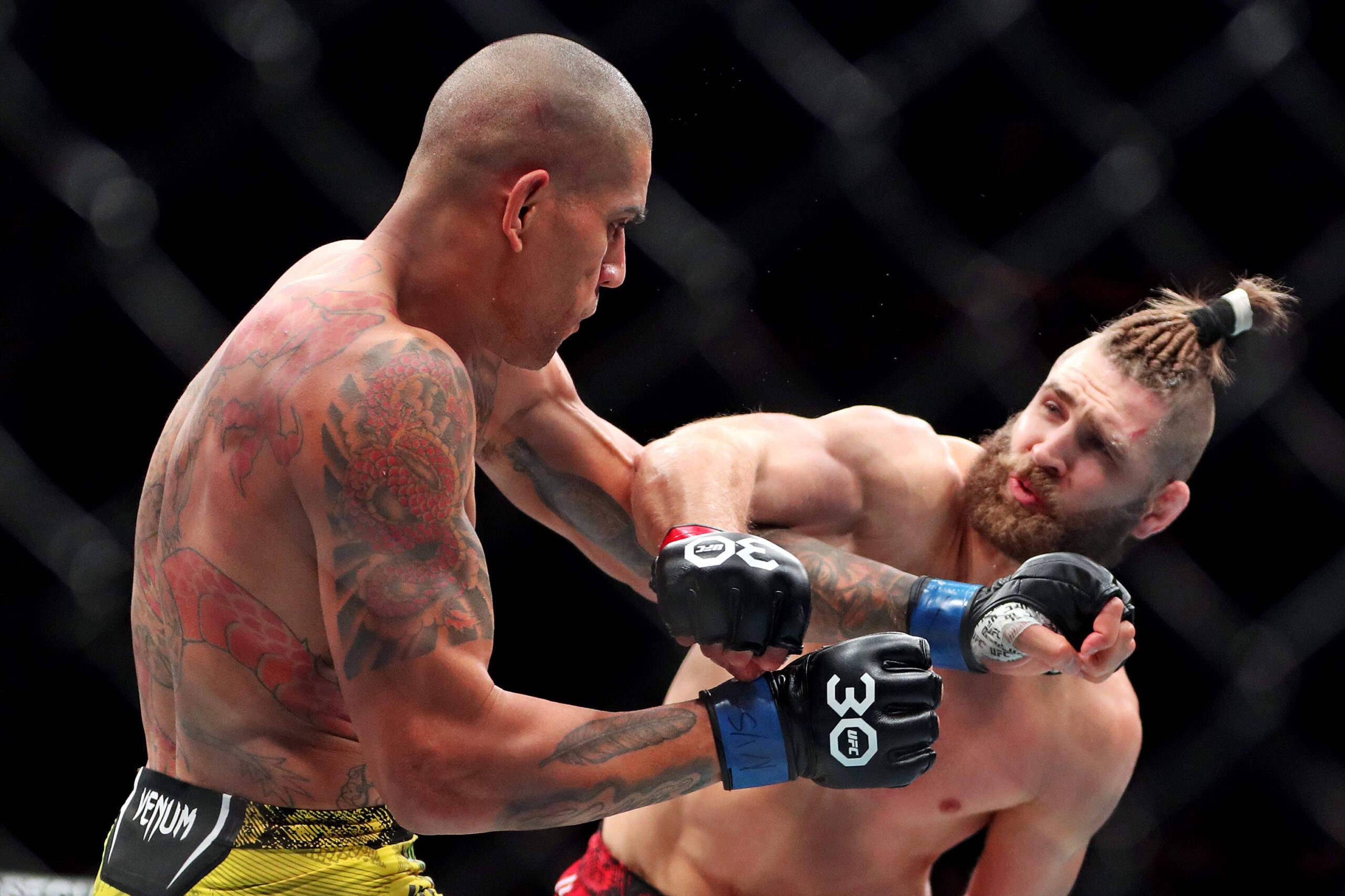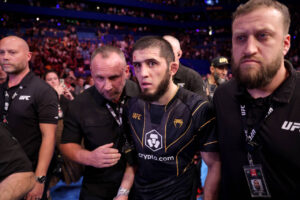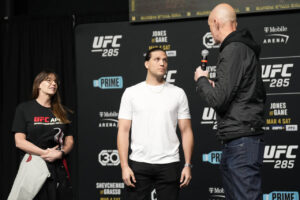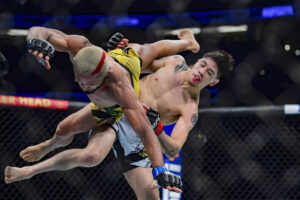Jump to
This UFC 295 technical breakdown first appeared on the Bloody Elbow Substack. For exclusive and premium pieces like this, please subscribe today.
UFC 295: The staredown
UFC 295 reminded me of how there’s nothing quite like a fight bubbling with such potential violence that no additional hype is needed. Absent of pageantry and cringeworthy verbal sparring, the best fights immediately carve out a home in our minds when we see the two names written next to each other.
Anticipation culminates at the in-cage staredown. Even the separation of hundreds of miles and the artificial barrier of a TV screen isn’t enough to calm our heartbeats. For a moment, all our cynicism dissipates.
Regardless of the tumultuous state of the UFC’s light heavyweight division, when Jiří Procházka and Alex Pereira stood staring at each other from across the cage, I was reminded of another fight two decades prior that fits into the same category.
UFC 295’s Jiri Prochazka versus Alex Pereira was a throwback to a time when MMA was more like Street Fighter. Dynamic specialists with crippling flaws engaged in weird chaotic brawls, occasionally getting stuck in an excruciatingly slow stalemate when a fighter knew nothing of BJJ other than a basic guard.
While the fight was truncated by a dynamite left hook, as is the case in so many Alex Pereira fights, for nine minutes we were still treated to a fair share of intrigue, technical brilliance, and action.
Pereira’s kicks were an immediate problem at UFC 295
Just a minute into the first round, Pereira hit Procházka with a calf kick that swept him off his feet. The sound echoed throughout Madison Square Garden. After seeing the success Pereira found with his no-tell calf kick in bouts with Israel Adesanya and Jan Blachowicz, Procházka surely wanted to avoid them.
However, the issue was that Procházka’s favored stance makes him more vulnerable to low kicks and it’s not so easy to adjust something so foundational to his style. He always employs a wide stance with his weight heavily biased onto his front foot, making it very difficult to quickly pick up and turn out his lead shin to check a kick.
Procházka’s only real option was to try to anticipate Pereira’s kicks and retract his lead leg. The problem was that Pereira’s unique mechanics forego turning over his hips and remove nearly every indication that the kick is coming.
This created a real strategic problem for Procházka, who wanted to fence with Pereira from a long distance. Without the crippling effect of Pereira’s calf kicks, Procházka might have been able to use his length and darting blitzes to compete with Pereira at range.
Procházka’s crafty setups
Despite his vulnerability to calf kicks, Procházka was still able to find success at range by using feints and misdirection. Pereira was proactive with his low kicks but mostly reactive with his boxing, which gave Procházka the chance to draw out responses and punish them.
This success was mostly unsustainable though. Procházka landed some good shots, but they weren’t damaging Pereira as much as the low kicks were damaging him. Procházka had to adjust his strategy.
It’s not a kickboxing fight
Procházka has never relied on offensive grappling. He’s a striker through and through. But hyper competitive athletes will typically do whatever it takes to win and Procházka had no qualms about taking the fight to the mat after he was fed up with eating debilitating calf kicks.
It was in this exchange that we were also reminded that, despite his success across multiple weight classes, Pereira is still a specialist with serious vulnerabilities in the grappling department. That was most clearly seen in his response to Procházka’s initial single leg attempt. Rather than immediately fighting grips and pummeling for an underhook, Pereira just tried to frame and land some punches.
Pereira’s ability to hip out and wall walk was encouraging, but Procházka wasn’t a skillful enough top position grappler himself to make it difficult for Pereira. Most importantly, Procházka needed to control the legs and hips of Pereira when he had him against the fence. One way to achieve this would have been with a leg mount, using his own legs to wrap up Pereira’s and leaving his own hands free to control the wrists.
Still, despite Procházka’s limitations from top position, he did manage to find a few openings to land hard elbows.
Procházka swarms
After finding little success from top position, Procházka returned to a striking-based approach in round two. But this time, he committed to backing Pereira up, correctly determining that it would be much harder for Pereira to land the low kicks while moving backward. To achieve this, he used feints. This worked because Pereira’s main line of defense is his long guard and range, so when faced with a threat he will often just hop backwards and stick his arms out to obstruct his opponents.
Despite Pereira’s willingness to concede space, when he felt determined to stay off the fence he was able to use his jab to dissuade Pereira from pressuring. Even though Pereira wasn’t very active with his jab, every time he threw it, he did it with purpose. His body jab allowed him to back Procházka off and his pivot jab allowed him to circle safely.
In the second round, a new pattern started to emerge. Whenever Pereira landed a calf kick, Procházka was reminded that he needed to pressure. When he did, he found success, but he was also walking into a woodchipper. Still, Procházka found his greatest success of the fight when he launched an all out assault on Pereira.
The issue though was that Procházka couldn’t maintain this intensity for the entire duration of the round, let alone for the three more rounds following this if the fight went there. Immediately after his successful offensive onslaught, Procházka relented and backed himself up to reset.
Nowhere safe against Pereira
Procházka desperately needed a safety valve. After blowing his wad halfway through the second round, Procházka was looking for a way to rest and recharge. This is not to say that his stamina was lacking; even the most well conditioned flyweights can’t go full throttle indefinitely. Every fighter looks for opportunities to rest in a fight and great fighters build tools into their games to create moments to do that safely…
To read the rest of this UFC 295 technique breakdown, head on over to the Bloody Elbow Substack. You can read the rest of this article there for free. This piece, and many like it, are made possible by paid subscriptions to our Substack. If you like this kind of work, and want to support its production, please pick up a yearly paid subscription to day.
Bloody Elbow merch now available
Bloody Elbow is pleased to announce our partnership with Revgear. They have been a pioneer in the MMA gear industry and have grown into a formidable brand and true leader in the market. Revgear now have Bloody Elbow t-shirts, hoodies and hats so you can show your support for independent MMA journalism.
Join the new Bloody Elbow
Our Substack is where we feature the work of writers like Zach Arnold, John Nash and Connor Reubusch. We’re fighting for the sport, the fighters and the fans. Please help us by subscribing today.
About the author





